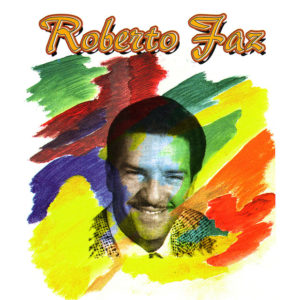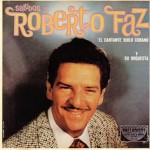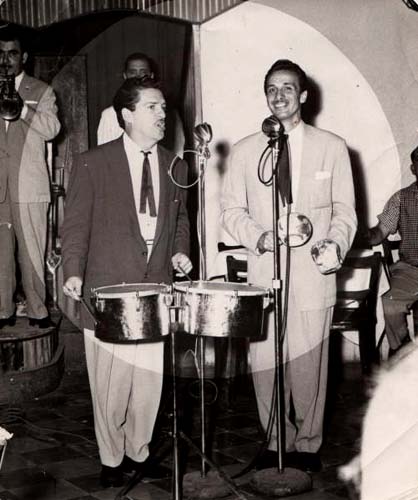 ROBERTO FAZ, UNO DE LOS MEJORES SONEROS QUE TUVO CUBA.
ROBERTO FAZ, UNO DE LOS MEJORES SONEROS QUE TUVO CUBA.
Roberto Faz Monzón, uno de los mas populares cantantes que ha tenido Cuba nació un 18 de Septiembre de 1914 en el pueblo de Regla.
Ya en 1930 Roberto Faz era parte del Septeto Ultramar organizado por su padre y dos años más tarde (1932) ya era vocalista de las Orquestas Copacabana, Continental y poco después en el Grupo Habana. En 1935 en el famoso cabaret Sans–Souci actúa con la famosa Orquesta Hermanos Palau donde el estilo de Roberto Faz comienza a ser notorio. A partir de 1936 no solo canta sino también es un excelente ejecutante de percusión como el bongó, las congas y pailitas criollas en las Orquestas Cosmopolita donde actuaba en los programas de Radio Cadena Habana y CMQ con la Banda de los Hermanos Lebatard.
En 1941 es cantante y percusionista en el Hotel Nacional con la orquesta del maestro Osvaldo Estivill en compañía del cantante Tito Gómez y tres años más tarde es cantante oficial del famoso conjunto Kubavana con el que actuó en el cabaret Zombie Club y realizó sus primeras grabaciones comerciales como la guaracha “No me importas tú”, de Mario Recio, y el bolero “¿Por qué te vas tan pronto?”, de Hugo Cruz, entre otras. Pero su verdadera consagración la logra en 1944 cuando es llamado por el cantante y director Roberto Espí para cantor en su Conjunto Casino, donde con el tiempo se convirtió en su vocalista más significativo y popular. Con dicha agrupación Roberto Faz realizó sus primeras giras al exterior, Puerto Rico, Venezuela (1945–1946) y poco después a Tampa, Cayo Hueso, Panamá y México, país en el que es muy conocido por sus grabaciones para la RCA Victor y desde 1948 para la Panart de Cuba.
Desde 1950 Roberto Faz y el Conjunto Casino con su mitológico trío de voces de Roberto Espí, Roberto Faz y Agustin Ribot, y más tarde por Rolito y Reyes logran grandes triunfos en toda Latinoamérica. La voz potente, clara y aguda, plena de musicalidad de Faz, se llegó a convertir en una de las más afamadas dentro del son, la guaracha y de manera muy especial en el bolero. Se recuerdan muchos títulos famosos con el Casino como “Realidad y fantasía”, de Cesar Portillo de la Luz, “Quiéreme y verás”, de J. A. Méndez y la guaracha “Que se corra la bola”, de A. Ruíz. En los primeros años de la década del cincuenta actúa con el Casino en principales programas de la televisión cubana.
https://youtu.be/r84BpzltPjo
El 1956 Roberto Faz funda su popular conjunto con algunos músicos del Casino y los cantantes Orlando Reyes y Loelangel Rodríguez haciendo su debut en los salones del Liceo de Regla, su pueblo natal. Y después actúan en el Hotel Sevilla Biltmore, en el Casino Deportivo, el Stadium Tropical y el conocido cabaret Alí Bar Club, junto a Fernando Álvarez y haciendo dúo con el gran Benny Moré.
En 1957 hace su primer larga duración con su agrupación para los disco Panart de una factura excelente en grabación y musicalmente. La voz de Faz y su conjunto tienen un éxito rotundo especialmente con el bolero “Comprensión”, de C. Doval y los sones “Como vivo en Luyanó”, de R. Barrera y “Cositas que tiene mi Cuba” de P. Zalazar. En 1966 Faz y su conjunto llegan al clima de la aceptación popular grabando dentro del estilo de los conjuntos de sones el denominado ritmo dengue. Obras como “Dengue de la cana”, de Montero y Castillo y del propio Faz, “Dengue en fa”, con un ritmo arrollador.
El sonero Roberto Faz con su presencia fraguaba optimismo y alegría.
Sustentaba toda su musicalidad probada en su afinación, ritmo y extensión vocal, así como su rica improvisación en guarachas y sones montunos. La excelente voz de Roberto Faz se encuentra registrada en cerca de cuatrocientas grabaciones, todas nutridas del son de los años treinta, las que constituyen un ejemplo de la música popular cubana hasta nuestros días.
Roberto Faz falleció el 26 de abril de 1966 en la Ciudad de La Habana.
 ROBERTO FAZ, ONE OF THE MOST POPULAR MUSICIANS OF THE OLD CUBA.
ROBERTO FAZ, ONE OF THE MOST POPULAR MUSICIANS OF THE OLD CUBA.
Roberto Faz Monzón, one of the most popular singers that Cuba has had, was born on September 18, 1914 in the town of Regla.
In 1930 Roberto Faz was part of the Ultramar Septet organized by his father and two years later (1932) he was already a vocalist of the Copacabana, Continental orchestras and shortly after in the Havana Group. In 1935, in the famous cabaret Sans-Souci, he performed with the famous Orquesta Hermanos Palau where Roberto Faz’s style began to be well known. From 1936 he not only sings but also is an excellent performer of percussion as the bongo, the congas and pailitas criollas in the Cosmopolitan Orchestras where he performed in the programs of Radio Cadena Habana and CMQ with the Banda de los Hermanos Lebatard.
https://youtu.be/W4FV1JNwwjk
In 1941 he is a singer and percussionist at the National Hotel with the orchestra of maestro Osvaldo Estivill in the company of the singer Tito Gómez and three years later he is the official singer of the famous group Kubavana with whom he performed at the cabaret Zombie Club and made his first commercial recordings like the guaracha “I do not care about you”, by Mario Recio, and the bolero “Why are you leaving so soon?” by Hugo Cruz, among others. But his true consecration was achieved in 1944 when he was called by the singer and director Roberto Espí to be a singer in his Conjunto Casino, where over time he became his most significant and popular vocalist. With this group Roberto Faz made his first tours abroad, Puerto Rico, Venezuela (1945-1946) and shortly after Tampa, Key West, Panama and Mexico, country where he is well known for his recordings for RCA Victor and from 1948 for the Panart de Cuba.
Since 1950, Roberto Faz and Conjunto Casino with their mythological trio of Roberto Espí, Roberto Faz and Agustin Ribot, and later by Rolito and Reyes have achieved great triumphs throughout Latin America. The powerful voice, clear and sharp, full of musicality of Faz, came to become one of the most famous within the son, the guaracha and very special in the bolero. Many famous titles are remembered with the Casino as “Reality and Fantasy” by Cesar Portillo de la Luz, “Quiéreme y verás” by J. A. Méndez and the “Que se corra la bola” guaracha by A. Ruíz. In the early years of the fifties, he played with the Casino in major Cuban television programs.
In 1956 Roberto Faz founds his popular group with some musicians from the Casino and singers Orlando Reyes and Loelangel Rodríguez making his debut in the halls of Liceo de Regla, his hometown. And then they perform at the Hotel Sevilla Biltmore, at the Casino Deportivo, the Stadium Tropical and the well-known cabaret Alí Bar Club, along with Fernando Álvarez and making a duet with the great Benny Moré.
In 1957 he made his first full-length album with his group for the Panart album, an excellent recording and musical score. The voice of Faz and his group have a resounding success especially with the bolero “Comprensión” by C. Doval and the sones “Como vivo en Luyanó” by R. Barrera and “Cositas que tiene mi Cuba” by P. Zalazar. In 1966, Faz and his group arrive at the climate of popular acceptance recording the so-called dengue rhythm within the style of the sets of sones. Works like “Dengue de la cana”, by Montero y Castillo and Faz himself, “Dengue en fa”, with a sweeping rhythm.
The sonero Roberto Faz with his presence forged optimism and joy.
He supported all his proven musicality in its tuning, rhythm and vocal extension, as well as his rich improvisation in guarachas and sones montunos. The excellent voice of Roberto Faz is recorded in about four hundred recordings, all nurtured from the sound of the thirties, which are an example of Cuban popular music to this day.
Roberto Faz died on April 26, 1966 in the City of Havana.
Agencies/ Wiki/ RodriguezBSon/ Internet Photos/ YouTube/ Arnoldo Varona/ www.TheCubanHistory.com
THE CUBAN HISTORY, HOLLYWOOD.



 < ROBERTO FAZ, One of the Most Popular Cuban Singers. VIDEOS.
< ROBERTO FAZ, One of the Most Popular Cuban Singers. VIDEOS.




